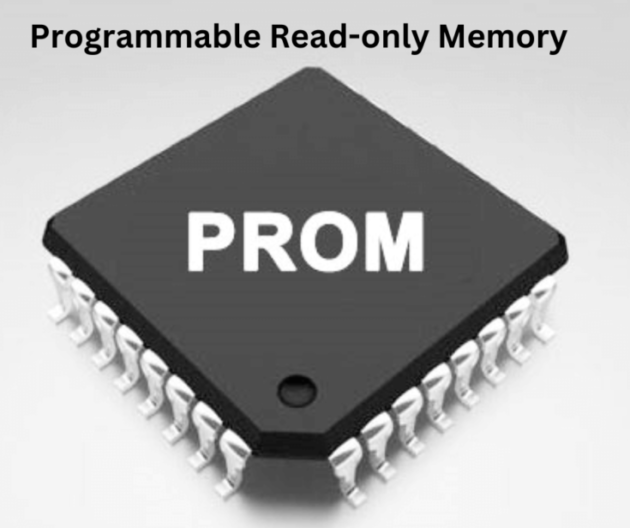In the world of computer hardware, the acronym “PROM” stands for Programmable Read-Only Memory. PROM is a fascinating piece of technology that plays a crucial role in the functioning of various electronic devices and systems. Let’s delve into the world of PROM, understanding its meaning, applications, and how it differs from other types of memory.
Introduction to PROM:
In the vast landscape of computer memory technologies, one acronym stands out: PROM or Programmable Read-Only Memory. Often used in computers and various electronic devices, PROM plays a critical role in storing data that needs to be both secure and unalterable throughout the device’s lifetime.
What is PROM?
At its core, PROM is a type of non-volatile memory, which means it retains data even when the power is turned off. What makes PROM unique is its one-time programmable nature. During the manufacturing process, specific information is programmed into PROM, and this data remains permanently etched, impervious to alterations or erasures.
PROM’s Function and Significance:
PROMs are invaluable in scenarios where data permanence is of utmost importance. Think of a situation where a computer or an electronic device needs to store vital information, like system firmware, unique identification codes, or encryption keys. PROMs provide the ideal solution for these needs because they ensure that the data remains safe from tampering or corruption.
PROM Example:
To better illustrate the concept of PROM, let’s consider a specific example. Imagine a computer manufacturer producing thousands of PCs. Each motherboard needs a unique serial number or identification code for tracking and warranty purposes. PROM can be used to program this code during the manufacturing process. Once programmed, the code becomes a permanent part of the motherboard, and it cannot be altered. This unique identification code is crucial for various purposes, including warranty tracking and service.
The Working Mechanism of PROM:
PROM achieves its one-time programmable nature through a clever design involving fuses or anti-fuses. These fuses act as switches that can be selectively programmed. During manufacturing, specific fuses are “blown,” or programmed, to represent binary 1s, while the unaltered fuses represent binary 0s. Once the programming is complete, the data is essentially “burned” into the memory, becoming immutable.
PROM in Computers:
Computers are one of the primary domains where PROMs find extensive usage. The BIOS (Basic Input/Output System), a fundamental component of computer architecture, is often stored in PROM. The BIOS is a critical firmware that initializes hardware components during system startup and ensures proper communication between the hardware and software layers. Since the BIOS is responsible for booting up the computer, it is crucial that this code remains unaltered to ensure system stability and security.
When Was PROM Invented?
The history of PROM technology dates back to the late 1950s. It emerged as a significant breakthrough in the field of computer hardware. As technology advanced, PROM became an integral part of the electronics industry, finding applications in various domains.
Difference Between PROM and ROM:
PROM is often confused with ROM (Read-Only Memory), but they have distinct characteristics. Both PROM and ROM are non-volatile memory types, which means they retain data even when the power is turned off. The key difference between them lies in their programming:
1. PROM: PROM is initially blank and must be programmed during the manufacturing process. Once programmed, the data is permanent and cannot be altered. This one-time programmable aspect distinguishes PROM from other memory types.
2. ROM: ROM, on the other hand, stands for Read-Only Memory. Unlike PROM, ROM is pre-programmed during manufacturing and cannot be altered under any circumstances. The data in ROM is “read-only” in the sense that it is permanently embedded and cannot be changed, even during the manufacturing process.
Applications of PROM:
PROM technology finds applications in a wide range of electronic systems. Let’s explore some of the key domains where PROM plays a significant role:
1. Firmware Storage: PROMs are commonly used to store firmware in electronic devices. Firmware contains instructions that are essential for the proper functioning of hardware components. PROM ensures that this firmware remains secure and unchanged.
2. System Identification: PROMs are used to store unique identification codes or serial numbers in electronic devices. This helps in tracking and managing individual devices, a crucial aspect of product warranty and support.
3. Security Keys: PROMs are employed to store encryption keys and other security-related information. These keys are critical for safeguarding sensitive data and ensuring secure communication.
4. Embedded Systems: Many embedded systems, such as those found in appliances, automotive components, and industrial equipment, rely on PROMs for firmware storage. These systems often need to operate reliably for extended periods without any changes to their programming.
5. Legacy Systems: In some cases, older computer systems and equipment still in use rely on PROMs for critical functions. The one-time programmable nature of PROM ensures that these systems continue to function as intended.
Challenges and Limitations of PROM:
While PROM offers a high level of data security and permanence, it also has some limitations and challenges:
1. Limited Programmability: PROM’s one-time programmable nature is both an advantage and a limitation. Once programmed, data cannot be changed or updated. This inflexibility can be problematic in situations where updates or modifications are necessary.
2. Production Costs: The manufacturing process of PROMs involves specialized equipment and expertise, which can result in higher production costs compared to other memory types.
3. Size and Capacity: PROMs are typically used for storing relatively small amounts of data. When larger storage capacities are required, alternative memory technologies such as EEPROM (Electrically Erasable Programmable Read-Only Memory) or NAND flash memory are more suitable.
Conclusion:
In the realm of electronic devices and computing, PROM, or Programmable Read-Only Memory, plays a vital role in ensuring data permanence and security. Its one-time programmable nature makes it well-suited for applications where data integrity is paramount. Whether it’s the BIOS of your computer, the serial number on your smartphone, or encryption keys in a secure system, PROM is the silent guardian that ensures the data remains immutable and unassailable.
The history of PROM technology, dating back to the late 1950s, reflects its enduring relevance and importance in the ever-evolving world of electronics. While it may not be as versatile or flexible as some other memory technologies, its unique characteristics make it an indispensable tool in the arsenal of computer hardware and electronic device manufacturers.
As technology continues to advance, we can expect PROM to find new applications and evolve alongside other memory technologies. Its legacy in the world of computing and electronics is a testament to its enduring significance. In an era where data security and integrity are paramount, PROM remains a stalwart guardian, ensuring that the critical data it stores remains safe from alteration or tampering.
Frequently Asked Questions:
1. What is PROM, and how does it work?
Answer: PROM, or Programmable Read-Only Memory, is a type of non-volatile memory used to store data that remains unalterable after being programmed. During manufacturing, specific fuses or antifuses are programmed, representing binary 1s or 0s. Once programmed, the data is permanently etched into the memory, ensuring its permanence.
2. How is PROM different from ROM?
Answer: PROM and ROM (Read-Only Memory) are both non-volatile memory types, but their key difference lies in programming. PROM is initially blank and must be programmed during manufacturing, while ROM is pre-programmed during manufacturing and cannot be altered. PROM is “one-time programmable,” allowing data to be written once.
3. Where is PROM used in computers?
Answer: PROM finds extensive use in computers for storing firmware, including the BIOS (Basic Input/Output System). The BIOS is a crucial component responsible for initializing hardware during system startup, and PROM ensures the security and integrity of this firmware.
4. What are the limitations of PROM?
Answer: PROM’s one-time programmable nature means that once data is written, it cannot be changed or updated. Additionally, PROMs are typically used for relatively small data storage needs, and their production can be costlier due to specialized equipment and expertise.
5. Can PROM be used in modern electronic devices?
Answer: Yes, PROM technology is still relevant and useful in modern electronic devices. While it may not be as versatile as some other memory technologies, PROM is employed for scenarios where data permanence and security are essential, such as storing encryption keys, unique identification codes, and firmware in various electronic systems.
- How Does Automated Scheduling Save Time and Boost Engagement? - April 16, 2025
- 21 Delicious High Protein Foods - May 31, 2024
- Black Seed Oil: Health and Beauty Benefits - May 30, 2024




